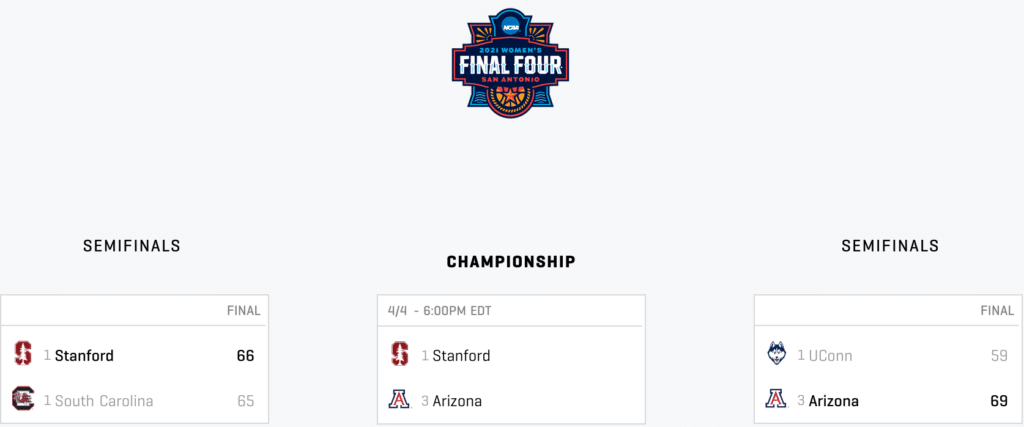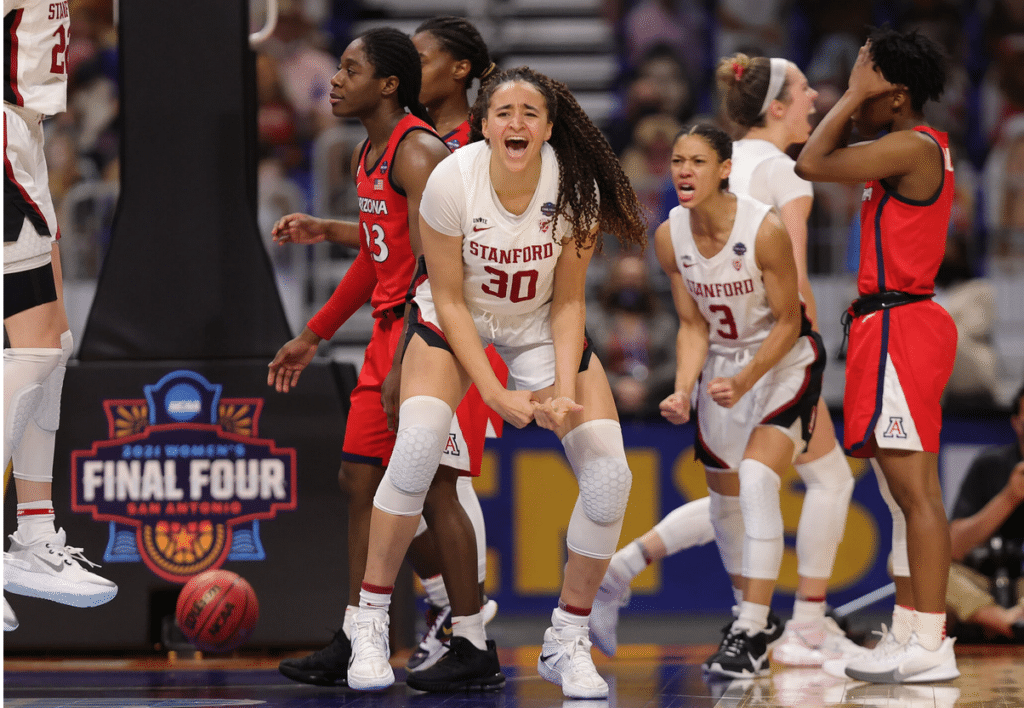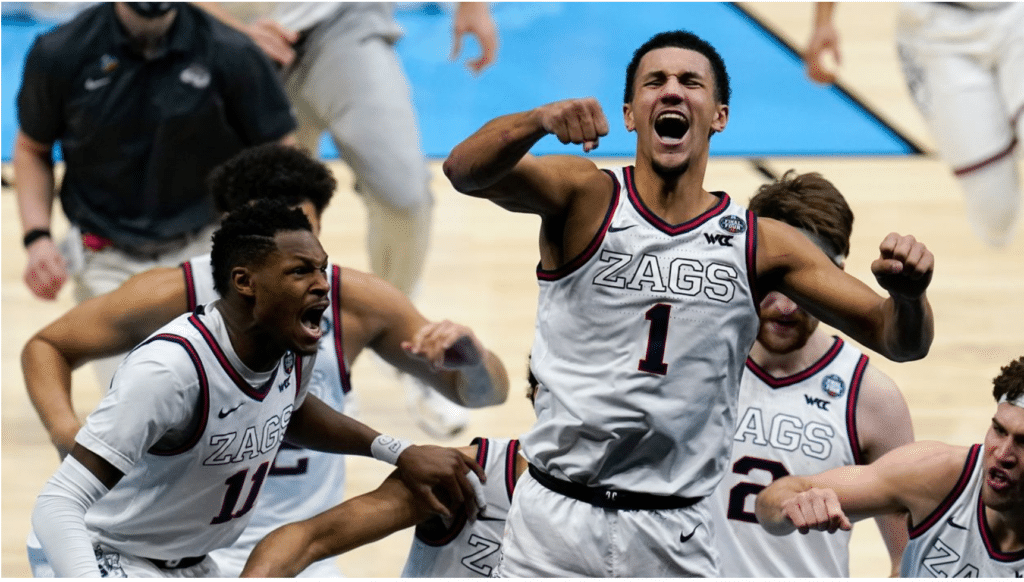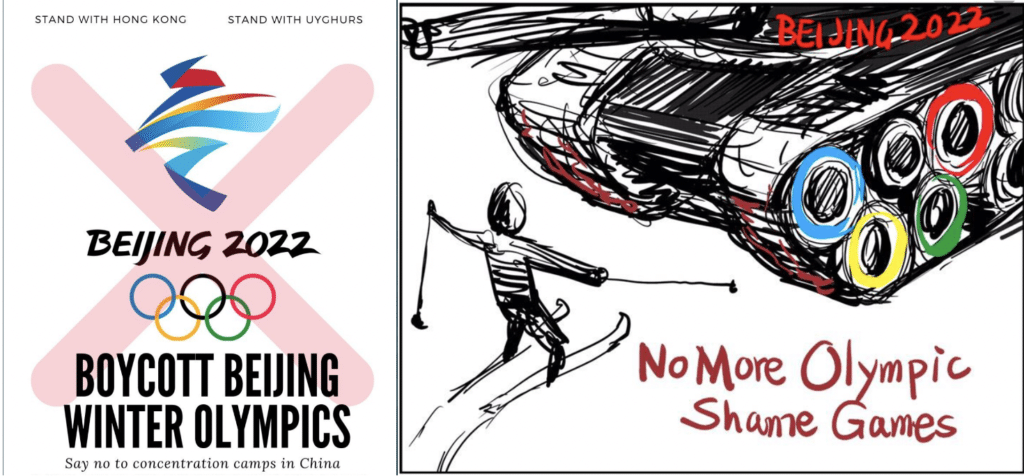Organizers hype the annual NCAA Division 1 women’s and men’s basketball tournaments as “March Madness.” They do so to exploit “the thrill of victory and agony of defeat” inherent in watching low-seeded teams (aka Cinderellas) upset top-seeded ones — often with buzzer-beating hail marys.
Unfortunately, these tournaments rarely live up to the hype, respectively.
Sure enough, the celebrated Final Four who made the women’s Big Dance this year included 1-seed Stanford and 1-seed South Carolina on one side of the bracket, and 1-seed UConn and 11-seed Arizona on the other. In other words, not a Cinderella in sight.
In a finish that came down to the last five seconds of the game, Stanford has won its third title, defeating Arizona, 54-53.
Stanford committed a shot clock violation with its final possession and a 1-point lead, giving the Wildcats five seconds to make history with their first title. They didn’t as Aari McDonald missed a final heave, and the Cardinal claimed their first championship since 1992. …
The was close until the very end, a fittingly intense ending to a tournament filled with close wins and heartbreaking losses.
(The New York Times, April 4, 2021)
I should note here that I intend to give the men’s tournament short shrift – for what I hope are obvious reasons. Except I’d be remiss not to acknowledge that they at least provided a little more bracketology drama. Because the celebrated Final Four who made the men’s Big Dance still included 1-seed Gonzaga and 11-seed UCLA on one side of the bracket, and 1-seed Baylor and 2-seed Houston on the other. Still, though, none of them can be fairly hailed as a Cinderella team.
Mind you, with respect to the popular bracketology (for office pools):
I decided years ago to forego the cheap thrill of filling out brackets and feigning agony as my picks got knocked off like ducks at a carnival shooting gallery. Granted, if I were still an indentured servant at a big law firm, I would’ve welcomed the respite from drudgery, which bracketology for office pools provides. The aim is clearly not to guess the result of each game; it’s to see whose bracket sustains the least number of casualties throughout the tournament.
(“NCAA March Madness — and Then There’s the Women of UConn,” The iPINIONS Journal, March 30, 2017)
That said, the title to that March 2017 commentary hints at my decades-long efforts to draw more media attention to the women’s game. Here is a sample of my forlorn pleading in this regard from “UConn Routs Louisville to Win NCAA (Women’s) Championship,” April 8, 2009:
_________
Instead of commanding network coverage in primetime like the men’s championship game, the women’s was relegated to cable last night, which guaranteed only a fraction of the viewership. TV executives wonder why they can’t get better ratings for the fledgling women’s professional league – the WNBA. Well, it might have something to do with the way they keep dissing women’s college basketball in this fashion.
Moreover, what does this disparate coverage say to female college athletes, as well as to young girls, who we encourage to have the same interest in sports as young boys? Frankly, it says that chauvinism, sexism, and discrimination against women in sports not only still exist but are blithely tolerated.
_________
By selling rights to air them only on ESPN, the NCAA made watching this year’s women’s Final Four and Championship games a luxury most Americans couldn’t afford. By contrast, it made sure watching the men’s Final Four and Championship games would be as basic as tuning in to your local CBS station.
But why not sell the rights to both women’s and men’s tournaments as a bundle to one broadcast network (CBS or ABC) so that they get similar TV coverage; you know, like tennis does with its grand slam tournaments?
Of course, NCAA executives justify this disparate treatment with circular arguments about the women’s game not being as popular and therefore not generating as much revenue as the men’s. Except that the USA women’s soccer team has been demonstrating for years that, if given an equal platform to their male counterparts, the women’s team can prove not only as profitable but even more popular.
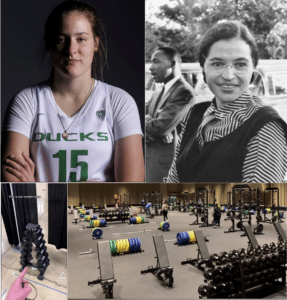 Indeed, this is why I was as bemused as I was enthused that it took Sedona Prince having a Rosa Parks-light moment for the NCAA to finally acknowledge the untenable inequities it imposes on female athletes. Like Parks, Prince was just sick and tired of the mistreatment, which on this occasion was so egregious, it begged to be called out. She obliged – and the way she did went viral
Indeed, this is why I was as bemused as I was enthused that it took Sedona Prince having a Rosa Parks-light moment for the NCAA to finally acknowledge the untenable inequities it imposes on female athletes. Like Parks, Prince was just sick and tired of the mistreatment, which on this occasion was so egregious, it begged to be called out. She obliged – and the way she did went viral
I duly commented in “NCAA Mistreating Women Is a Mainstay, Not a Mistake” March 23, 2021. But chances are you’ve seen her viral video that brought the NCAA to shame, albeit only temporarily.
It shows her first giving a tour of the training facility the NCAA provided for the women players. It was equipped with just some yoga mats and one, stumpy dumbbell tree with 12 weights that were more suitable for a pencil-thin Olive Oyl than any serious athlete. And then it shows her giving a tour of the facilities the NCAA provided for the men. It was so fully equipped, you got the impression Prince had been teleported to a LA Fitness center.
But nothing betrayed how intentional this mistreatment was quite like the NCAA transforming that one dumbbell tree into a spacious, fully-equipped training facility overnight. Which raises the question:
- If viral pressure could force the NCAA to do the right thing in that case, why not pressure it to treat women athletes equally; pay college athletes – as I’ve been calling for in commentaries like “Student Athletes Make Billions (for Colleges) but Most Graduate Poor … and Dumb,” January 16, 2014; and enforce minimum educational proficiency for student-athletes so that none graduate too dumb to read the writing on degrees not worth the paper they’re written on?
I refer you to my podcast episode 17: “End Indentured Servitude. Pay College Athletes,” January 16, 2021, for more on this looming categorical imperative. But beware that the case pending before the Supreme Court betrays its intent on affirming only gradual, incremental steps, instead of the one giant leap necessary to redress these persistent inequities.
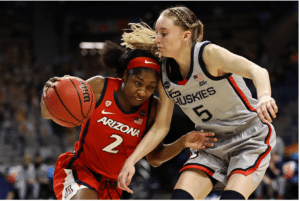 Meanwhile, what the hell is going on with the UConn Huskies. This is the fourth consecutive year these once-perennial champions have failed to even make it to the Final Dance. They have won 11 titles and have made it to the Final Four for thirteen consecutive years.
Meanwhile, what the hell is going on with the UConn Huskies. This is the fourth consecutive year these once-perennial champions have failed to even make it to the Final Dance. They have won 11 titles and have made it to the Final Four for thirteen consecutive years.
So, trust me folks, this is even more shocking than the Chicago Bulls, at the height of their Michael and the Jordanaires reign, suddenly failing to make it to the NBA finals for four consecutive years. Or, for the hoops challenged, this is like Tiger Woods, before his infamous fall from grace in November 2009, going four years without winning a major championship. That would have been unthinkable, right?
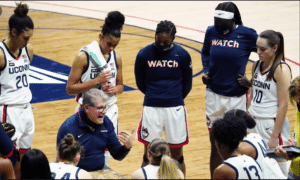 One wonders how UConn coach Geno Auriemma is explaining this streak of spectacular losses, not just to his naturally crestfallen players but to the entire sports world. I mean UConn lost to Arizona this year, a team that was making its very first appearance in the Final Four in tournament history.
One wonders how UConn coach Geno Auriemma is explaining this streak of spectacular losses, not just to his naturally crestfallen players but to the entire sports world. I mean UConn lost to Arizona this year, a team that was making its very first appearance in the Final Four in tournament history.
But, forget comparisons with Bulls coach Phil Jackson. Because sports writers were beginning to hail Auriemma as the second coming of legendary UCLA coach John Wooden, aka the Wizard of Westwood.
Apropos of which, it is noteworthy that I had just cause in 2010 to eulogize Wooden in a commentary titled “John Wooden, Pioneering Basketball Coach, Is Dead,” on June 22, 2010, and then to hail Auriemma in one titled “UConn Continues Longest Winning Streak in Sports History on December 22, 2010. Because, besides the uncanny coincidence, here is how I began my tribute to Wooden:
Does anybody care that the UConn women’s team is about to complete a second-consecutive perfect season by winning another NCAA championship tonight? Now just imagine the hoopla if North Carolina [or any men’s team] had won its championship in such convincing fashion.
In other words, I presaged the media double standard that is occasioning Gonzaga’s quest for a perfect season over a decade ago.
The Gonzaga freshman banked in a shot at the buzzer from just inside the half-court logo Saturday night to lift the Zags to a 93-90 overtime win over UCLA and move them one win away from an undefeated season and a national title.
This Final Four thriller was the best game of the tournament, and, considering the stakes, it served up possibly the best finish in the history of March Madness — a banker from near midcourt to keep a perfect season alive.
(The Associated Press, April 4, 2021)
Still, even I have to admit, that’s living up to the hype.
In any event, congrats to Stanford for winning it all. Not least because of what this says about the bona-fides of true student athletes. Indeed, a more athletic display of beauty, talent, and brains has never been seen.
 For the record, though, I could not have cared less who won the women’s tournament. And I care even less who wins the men’s. But I am willing to bet that the women’s games were far more exciting to watch, for the relatively few who tuned in, than the men’s.
For the record, though, I could not have cared less who won the women’s tournament. And I care even less who wins the men’s. But I am willing to bet that the women’s games were far more exciting to watch, for the relatively few who tuned in, than the men’s.
And, lest you think this is just my libido getting the better of my brain, here is how no less an authority than Dave Kindred laid the unassailable premise for my contention in a 60 Minutes interview on March 28:
The women athletes, you know I love seeing them play. And why should they be ignore. … The men’s game is vertical. The [women’s] game is horizontal. They have to master the fundamentals. So it’s much more fun to watch them. And plus, they don’t pout. They don’t bitch.
Now, if you have no clue who Dave Kindred is, I hope it suffices to know that he is to sports writing what Jim Nantz (of “a tradition unlike any other”) is to sports announcing. But I suspect his point about the women’s game being horizontal, the men’s vertical, is just Kindred’s professional way of saying the women’s game is more strategic and suspenseful. In fact, the analogy to chess and checkers comes to mind. Only in this case, I’d say the women’s game is to chess as the men’s is to dominoes.
Finally, given the way #BoycottBeijingOlympics is trending right now, I feel obliged to at least share a passing comment.
You are probably aware that Western governments have declared China’s treatment of Uyghurs a genocide. President Biden has led them in leveling “targeted sanctions,” which of course is a far cry from an Olympics boycott. But, perhaps fearing the trend, influential US Senator Mitt Romney proposed a “diplomatic boycott” to spare the athletes.
Except that Biden must know that sanctions are woefully insufficient to honor pledges that “never again” will Western leaders stand by while any state perpetrates genocide. More to the point, though, even more than Putin’s Russia, Xi’s China has just cause to believe that it can act with impunity. Western companies like Google, Philips, and Siemens have seen to that.
This is why I submit the only way Western countries can regain the moral high ground in their dealings with China is to relocate the 2022 Beijing Olympics based on the same principle that moved them to boycott the 1980 Moscow Olympics. The categorical imperative for doing the former is clearly greater. Let the political and economic chips fall where they may.
As for the Uyghurs, who I wrote about in “It’s Official: China Committing Genocide Against Uyghurs. Now What?” March 10, 2021, I fear we can only hope the Chinese treat them better than Hutus treated Tutsis, Janjaweed treated Darfurians, and Buddhists treated Rohingyas.
But, so much for turning to sports to get away from politics, eh? Ha!
Related commentaries:
Longest winning streak… NCAA mistreating women… Uyghurs…
